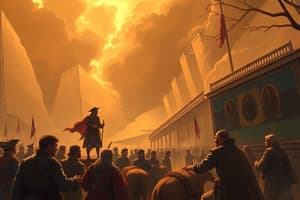Podcast
Questions and Answers
The Articles of Confederation served as the first ______ of the newly formed United States of America.
The Articles of Confederation served as the first ______ of the newly formed United States of America.
constitution
Ratification of the Articles occurred in ______.
Ratification of the Articles occurred in ______.
1781
Congress lacked the power to ______, relying on contributions from the states.
Congress lacked the power to ______, relying on contributions from the states.
tax
Amending the Articles required ______ consent from all thirteen states.
Amending the Articles required ______ consent from all thirteen states.
The absence of an executive branch led to administrative ______ and difficulties in enforcing laws.
The absence of an executive branch led to administrative ______ and difficulties in enforcing laws.
The Articles established a unicameral ______ composed of delegates from each state.
The Articles established a unicameral ______ composed of delegates from each state.
The Annapolis Convention was a crucial pre-cursor to the ______ Convention.
The Annapolis Convention was a crucial pre-cursor to the ______ Convention.
States often pursued their own interests over ______ interests, resulting in a fragmented government.
States often pursued their own interests over ______ interests, resulting in a fragmented government.
The Articles focused on establishing a limited and decentralized government, prioritizing ______ autonomy.
The Articles focused on establishing a limited and decentralized government, prioritizing ______ autonomy.
The Articles of Confederation successfully guided the nation through the crucial years following the ______ War.
The Articles of Confederation successfully guided the nation through the crucial years following the ______ War.
Flashcards
Articles of Confederation
Articles of Confederation
The first constitution of the United States, adopted in 1781, which established a 'league of friendship' among the thirteen states with a weak central government.
Weak Central Government
Weak Central Government
The Articles of Confederation created a weak central government with limited powers, leaving most authority to the states.
Congress Under the Articles
Congress Under the Articles
The Articles established a unicameral legislature called Congress, composed of delegates from each state with only one vote per state.
Absence of Executive Branch
Absence of Executive Branch
Signup and view all the flashcards
Lack of a National Court
Lack of a National Court
Signup and view all the flashcards
Inability to Tax
Inability to Tax
Signup and view all the flashcards
Unanimous Amendment Requirement
Unanimous Amendment Requirement
Signup and view all the flashcards
Successes of the Articles
Successes of the Articles
Signup and view all the flashcards
Annapolis Convention
Annapolis Convention
Signup and view all the flashcards
Limited and Decentralized Government
Limited and Decentralized Government
Signup and view all the flashcards
Study Notes
Introduction
- The Articles of Confederation served as the first constitution of the newly formed United States of America.
- It established a "league of friendship" among the thirteen states, rather than a unified national government.
- Ratification of the Articles occurred in 1781.
Key Features of the Articles
- Created a weak central government with limited powers.
- Congress held primary power, but state governments retained significant autonomy.
- No executive branch or national court system existed.
Weaknesses of the Articles
- Congress lacked the power to tax, relying on contributions from the states.
- This created significant financial instability and hindered the ability to pay war debts.
- Congress struggled to regulate commerce between states, leading to interstate disputes and economic hardship.
- States often pursued their own interests over national interests, resulting in a fragmented and ineffective government.
- Amending the Articles required unanimous consent from all thirteen states, rendering significant changes nearly impossible.
- The absence of an executive branch led to administrative inefficiencies and difficulties in enforcing laws.
- The lack of a national court system exacerbated the problems of interstate disputes and a clear system of justice was absent.
Successes of the Articles
- Successfully guided the nation through the crucial years following the Revolutionary War, including negotiation of the Treaty of Paris.
- Established a framework for westward expansion and organizing new territories and states.
- Helped solidify a sense of national unity, even with weaknesses.
- Provided the foundational experience for a stronger, more unified government under the Constitution.
Key Provisions
- Established a unicameral legislature (Congress) composed of delegates from each state, each holding one vote.
- Congress held limited powers, primarily focusing on foreign affairs, war, and trade.
- Each state retained its sovereignty and independence.
- The Articles focused on establishing a limited and decentralized government, prioritizing state autonomy.
The Annapolis Convention
- A crucial pre-cursor to the Constitutional Convention.
- Called in response to the struggles under the Articles, specifically the issues with trade and commerce.
- A small gathering of delegates from several states, aiming to discuss trade issues.
- While not a huge success in its aims, it highlighted the need for a stronger national government and paved the way for the Philadelphia Convention.
Transition to the Constitution
- The inadequacies and weaknesses of the Articles of Confederation, including economic problems, interstate disputes, and inefficiencies in governance, became apparent.
- The need for a more robust and unified national government spurred the push for a constitutional convention.
- The Philadelphia Convention (1787) ultimately drafted the United States Constitution, marking a departure from the decentralized structure of the Articles.
Studying That Suits You
Use AI to generate personalized quizzes and flashcards to suit your learning preferences.




